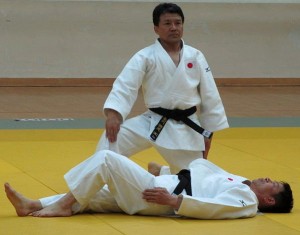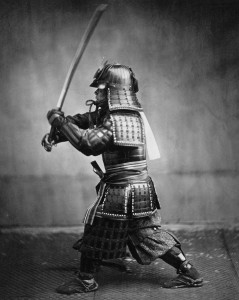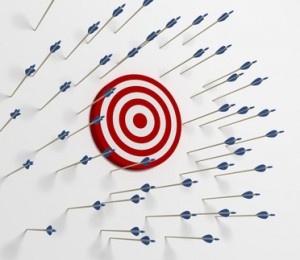
In its never-ending quest to improve its production, Toyota has identified the three evils of any manufacturing system: waste (muda), unevenness (mura), and overburden (muri). In this post I will explain the concepts behind these three banes of manufacturing.
It All Started with a Good Fight(er)

The terms muda, mura, and muri (waste, unevenness, and overburden) are actually not an invention by Toyota. They were used in Japanese martial arts long before Toyota.
In martial arts, any excess movement in combat is a waste, since it tires the athlete and leaves him open for an attack. Similarly, any uneven or unnatural movement or thought, or an unnatural stance, will hinder your actions. Finally, trying to do too much at the same time or using techniques that you have not yet mastered is overburden.

The martial artist eliminates these three problems through the three pillars of martial arts: Kihon (基本): practicing basic moves; Kata (形 or 型): repetitive exercise of predefined moves; and Kumite (組手): free combat practice.
However, these are only techniques to practice. Additionally, marital artists also strengthen the body through exercises (hojo undo, 補助運動; and taishou, 体操). Finally, they also train the mind by building up a fighting spirit (seishin tanren, 精神 鍛錬, literally forging the spirit). Altogether they form the way of war (budō, 武道) in order to help you on the way of the warrior (bushidō, 武士道).
From Destruction to Creation

While bushido aims for the destruction of your opponent, lean manufacturing aims for the creation of value. Yet both should be relentless in the pursuit of these goals. As martial arts follows the way of the warrior, lean manufacturing should have a similar way of the manufacturer (which, loosely translated, would be seisanshado, 生産者道, although this is not an actual Japanese word). In any case, for my lean combat gear, see Seven Gadgets for the Basic Lean Toolkit 🙂 .
Nevertheless, the martial arts approach to perfection can help us here. So, let’s go into the details of muda, mura, muri:
Waste (Muda)
Muda (無駄): futility; uselessness; pointlessness; waste;
 The most famous of the three evils of manufacturing is waste (muda). This is commonly divided into the famous seven types of waste:
The most famous of the three evils of manufacturing is waste (muda). This is commonly divided into the famous seven types of waste:
- Transportation
- Movement
- Waiting
- Over-Processing
- Defects and Rework
- Inventory
- Overproduction (the worst one)
Of course, since Toyota developed the concept, many additional types of waste have been added. Most well known is probably wasted human creativity, but I have found at least twenty-four more types that are used somewhere. However, in my opinion, a lot of these types of waste are themselves a waste. Overall, the topic of muda is too long to be covered here. Please see my post The Seven Types of Waste (Muda) – Bonus: Now with 24 More Types of Waste Absolutely Free! for more details on waste and its types.
In my view, the Western world puts way too much focus on eliminating waste, and neglects the elimination of unevenness and overburden. Don’t do that! You will never reach the full potential if you only look at one of the three evils.
Unevenness (Mura)
Mura(斑): unevenness; inconsistency; erraticness; irregularity; lack of uniformity;
As the translation states, mura is any kind of unevenness or irregularity. While often used mainly for material flow, it is also a problem in many other cases outside of material flow. The following is a list of examples where unevenness could happen and cause problems:
- Uneven customer demand
- Inventory swings – from too much to too little
- Uneven production speed or changing production quantities
- Uneven quality of good parts (however, if the part fails or has to be scrapped it is waste)
- Irregular or erratic working rhythm
- Uneven training of the workers
- Uneven distribution of the workload

Often, leveling, or just in time, is seen as countermeasures to mura. However, in my view, this is a too-narrow focus on material flow. Additionally, simply implementing leveling may actually make things worse (see my posts on leveling, especially the one on The Folly of EPEI Leveling).
You will have to watch for unevenness in many more places. Also, there is no standard cure (in fact, in lean manufacturing there is rarely a standard cure for problems). While work standards may often help, it depends on the type of unevenness and the details of the system to determine the best countermeasure.
Historically speaking, unevenness was probably the last of the three evils that have been identified in manufacturing. Of course, there were side effects of other methods that reduced unevenness, as for example Henry Ford and his assembly line. However, one early example was probably the use of a production rhythm in German Junkers aircraft manufacturing by 1930. This method made it to Mitsubishi in Japan, from there to Toyota, and then to lean manufacturing throughout the world, while all the time retaining its German word “Takt” (rhythm, timing, beat).
Overburden (Muri)
Muri (無理): unreasonableness; impossible; overdoing; beyond one's power; too difficult;
Again, as per translation, muri is overburden, unreasonableness, and things that are too difficult. Naturally, the main focus here is on people. However, it also can apply to materials, machines, and organizations. Here are a few examples:
- People
- Working too long hours (and yes, I am frequently guilty of that myself)
- Heavy lifting
- Unsuitable posture or inadequate ergonomics
- Noise
- Too-difficult tasks
- Too-easy tasks (which may be boring or mentally tiring)
- Excessive stress
- Anything that leads to burn out, bore out, or repetitive strain injury
- Lack of training
- Humiliation, but possibly also excessive praise
- Dangerous, dirty, and difficult tasks (the 3K in Japanese)
- Organizations
- Demanding that the supplier delivers what we want whenever we want it without providing a good and stable signal from our side
- Abusing your market power to fleece suppliers or customers (I feel this temptation may be difficult for many companies in the western world to avoid)
- Machines and Materials
- Pushing machines and tools to the limits of its capabilities, leading to increased wear and tear
- Skipping maintenance (you can skip an oil change in your car, but your car won’t like it)
- Mistreatment of materials; e. g., storing parts in unsuitable conditions
- Loading a vehicle or container beyond its weight limits

Similar to unevenness, there is no catch-all countermeasure. Depending on the type of overburden and the system, a different solution may help. Sometimes 5S is the answer, sometimes improved ergonomics, or sometimes just plain old respect for your fellow human beings. Also, similar to unevenness, it is often neglected in the Western world, where the focus is on eliminating waste.
Historically, avoiding overburden also happened before Toyota. For most of history, employers tried to get the most out of their employees, usually by having them work harder and longer. Only during the end of the nineteenth century did employers realize that working less is actually more productive, gradually reducing working times from up to sixteen hours per day to eight hours or even less. To their surprise, productivity increased – not only by the hour but per day. Even nowadays it is a well known secret that your most productive workers are often part-time workers.
4M and 5M – but more is not better here…
By the way, besides these 3M there is also a 4M and even a 5M, although they do not originate from martial arts or Toyota. The two additional M’s are Muchi (無知) for ignorance and Mushi (無視) for ignoring (yes, I now they are almost the same). I found very few references for these together with muda, muri , and mura (one in Japanese and one in Indonesian). I think you can safely ignore them, unless you want to impress people with more buzzwords. However, if someone tries to impress you with these buzzwords, now you know them!
Summary
Of course, now that you know the three evils in detail, you would be interested in how to banish them. Unfortunately, this would exceed this post. This would also exceed a whole series of posts. In fact, the entire Toyota Production System aims to reduce these three. Hence, you could say that this entire blog describes how to reduce these three evils, and even then it would be incomplete.

In fact, I believe it is impossible to eliminate all three completely. The more you have eliminated, the harder it is to fight the remaining traces of muda, mura, and muri. Yet, if you stop eliminating these evils, they will grow again. Also, if you look only at one of them and neglect the others, system performance will not increase. Hence, do not forget mura (unevenness) and muri (overburden). Therefore, go out and organize your industry, even though your work on this will never end.

I want to know what is 3M
Hi Naveen, 3M is Muda Mura Muri, see also my glossary https://www.allaboutlean.com/lean-glossary/#3M
what is the future of lean in manufacturing industry . i have just started my career in manufacturing industry. i have done M.Tech in production engineering. so any good scope for me as a production engineer in future perspective.
I would really like to see how the 3Ms (and Lean Manufacturing in general) would translate into a call center/tech support environment
Hi HQ, it is very similar: Do you have waste (waiting time? Calls that did not resolve the issue and had to be redone? etc.). Do you have Unevenness (lots of calls at some time and few at others? Workers very busy vs. idle?); Do you have Overwork (Workers over-or underloaded, stressed, etc.). Not everything has a perfect analogy, but you will definitely find muda, mura, and muri in call centers. Since call centers also often have a very standardized process, doing Lean is often not too difficult in call centers.